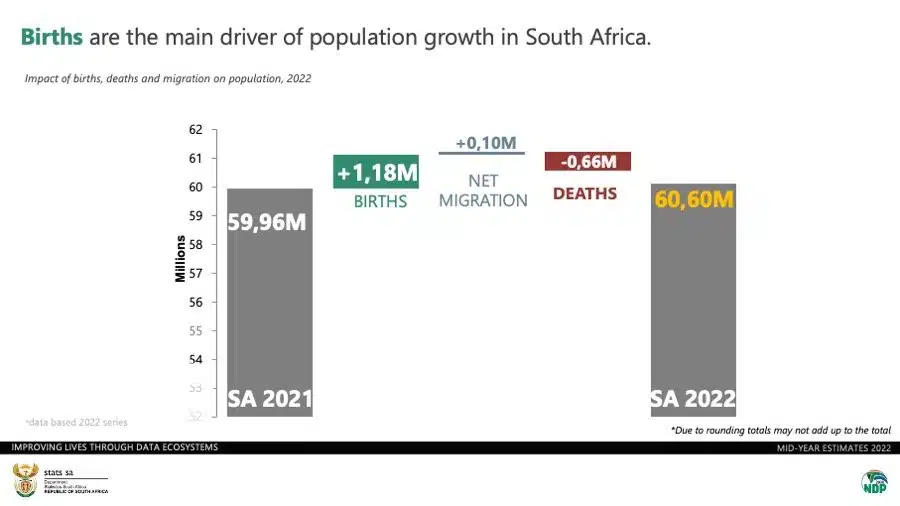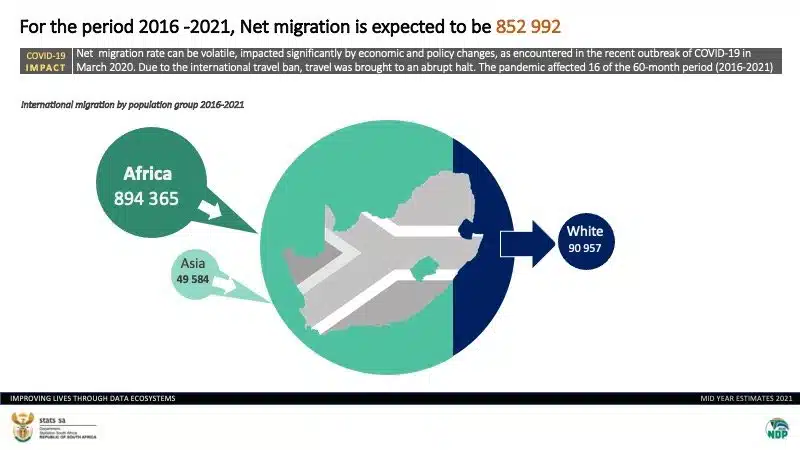
South Africa’s white population continues to shrink
Statistics South Africa has published its mid-year population estimates for 2022, showing that the country’s population continues to grow – now estimated to be 60.6 million people.
The country recorded a net increase of 640,070 people between estimates in 2021 and 2022, Stats SA said.
StatsSA also provided a breakdown of demographics, including the estimated shifts among different racial population groups.
Black South African estimates increased by 430,480 people over the period, while the country’s coloured population grew by 44,951. The Asian/Indian population group added 9,774 people over the last year.
South Africa’s white population, however, declined by 23,191 people between 2021 and 2022, Stats SA said.
The mid-year estimates for 2022 do not include data from census 2022. The census data will be published in 2023. The mid-year estimates will incorporate findings from the published census 2022 in the next series upon release in 2024.
South Africa’s white population has steadily declined over the years, with the population group declining by 17,311 in 2021.
The country’s white population’s proportionate make-up of the overall population has also declined from 7.8% in 2021 to at 7.7% in 2022. This has steadily declined over the years, from 7.9% in 2019, 8.1% in 2016, and 9.0% in 2011. In 2021, Stats SA pointed to emigration as a key factor in this declining trend.
Migration data over the 2016-2021 period shows that South Africa has seen a massive influx of foreign nationals over the last five years. Stats SA estimates that between 2016 and 2021 South Africa has seen net international migration of 852,992 people into the country.
This includes a large number of people entering the country from Africa (894,365), as well as a smaller number from Asia (49,854). However, the stats body estimated that around 91,000 white South Africans will have left the country over the period.
Looking ahead, this trend is likely to continue, the data shows.
Stats SA’s projections for the next five years (2021-2026) estimate that South Africa will see a net influx of 592,520 people, largely African. However, the white population is expected to see a net outflow of 43,516 people.
Stats SA said that its migration estimations come with a large caveat. Overall, the data shows there is a reduction in international migration, which is indicative of the Covid-19 travel restrictions and the subsequent impact on migratory patterns since March 2020.
The stats body stressed that projecting international migration post-June 2020 is a contentious activity, largely due to the context of a pandemic which resulted in a rather highly variable trajectory.
However, the figures reflected in the table above are based on an assumed resumption in migratory patterns – while not entirely to the level of pre-Covid-19, but on an upward trajectory.
The net international migration estimates are derived not only derived using its own migration data, but also migration numbers and proportions from various other authors, methods and data sources such as the OECD, and the International Organisation for Migration (IOM) which forms part of the UN network.
Census data from National statistics offices of various countries as well as migration data is also sourced, it said. “As migration data comes to the fore over time, migration assumptions will be revised accordingly,” Stats SA said.
Read: Massive wave of skilled South Africans moving to New Zealand







